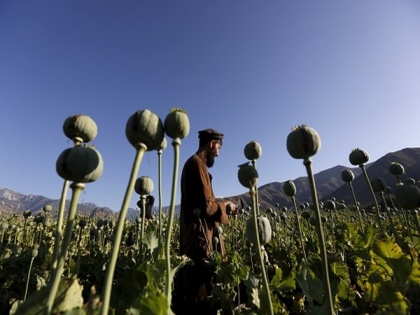Afghanistan opium cultivation in 2022 up by 32 per cent: UN survey
By ANI | Updated: November 1, 2022 23:45 IST2022-11-01T18:13:01+5:302022-11-01T23:45:07+5:30
The 2022 opium crop in Afghanistan is the most profitable in years with cultivation up by nearly one-third and ...

Afghanistan opium cultivation in 2022 up by 32 per cent: UN survey
The 2022 opium crop in Afghanistan is the most profitable in years with cultivation up by nearly one-third and prices soaring, according to a new research brief from the United Nations Office on Drugs and Crime (UNODC).
Opium cultivation in Afghanistan - latest findings and emerging threats is the first report on the illicit opium economy since the Taliban, which assumed power in August 2021, banned cultivation of opium poppy and all narcotics in April 2022.
This year's harvest was largely exempted from the decree, and farmers in Afghanistan must now decide on planting opium poppy for next year amid continued uncertainty about how the de facto authorities will enforce the ban. Sowing of the main 2023 opium crop must be done by early November 2022.
"Afghan farmers are trapped in the illicit opiate economy, while seizure events around Afghanistan suggest that opiate trafficking continues unabated," said UNODC Executive Director Ghada Waly upon the survey's launch.
"The international community must work to address the acute needs of the Afghan people, and to step up responses to stop the criminal groups trafficking heroin and harming people in countries around the world."
According to UNODC findings, opium cultivation in Afghanistan increased by 32 per cent over the previous year to 233,000 hectares - making the 2022 crop the third largest area under cultivation since monitoring began.
Cultivation continued to be concentrated in the southwestern parts of the country, which accounted for 73 per cent of the total area and saw the largest crop increases. In Hilmand province, one-fifth of arable land was dedicated to opium poppy.
"Opium prices have soared following the announcement of the cultivation ban in April. The income made by farmers from opium sales more than tripled from USD 425 million in 2021 to USD 1.4 billion in 2022 - the new figure equivalent to 29 per cent of the 2021 value of the agricultural sector. In 2021, the farm-gate value of opiates was only worth some 9 per cent of the previous year's agricultural output," the UNODC report said.
However, the increase in income did not necessarily translate into purchasing power as inflation has soared during the same period, with the price of food increasing on average by 35 percent.
"Following a drought at the start of 2022, opium yields declined from an average of 38.5kg/ha in 2021 to an estimated 26.7 kg/ha this year, resulting in a harvest of 6,200 tons, 10 per cent smaller than in 2021. The 2022 harvest can be converted into 350-380 tons of heroin of export quality, at 50-70 per cent purity," the report said.
Seizure events collected by UNODC's Drugs Monitoring Platform suggest that opiate trafficking from Afghanistan has been ongoing without interruption since August 2021. Afghan opiates supply some 80 per cent of all opiate users in the world.
( With inputs from ANI )
Disclaimer: This post has been auto-published from an agency feed without any modifications to the text and has not been reviewed by an editor
Open in app